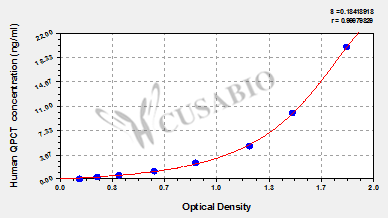-
中文名称:人谷氨酰胺酰肽环转移酶(QPCT)酶联免疫试剂盒
-
货号:CSB-EL019135HU
-
规格:96T/48T
-
价格:¥3600/¥2500
-
其他:
产品详情
-
产品描述:
This Human QPCT ELISA Kit was designed for the quantitative measurement of Human QPCT protein in serum, plasma, tissue homogenates. It is a Sandwich ELISA kit, its detection range is 0.312 ng/mL-20 ng/mL and the sensitivity is 0.078 ng/mL.
-
别名:5730422A13Rik ELISA Kit; EC ELISA Kit; GCT ELISA Kit; Glutaminyl cyclase ELISA Kit; Glutaminyl peptide cyclotransferase ELISA Kit; Glutaminyl tRNA cyclotransferase ELISA Kit; Glutaminyl-peptide cyclotransferase ELISA Kit; Glutaminyl-tRNA cyclotransferase ELISA Kit; Glutamyl cyclase ELISA Kit; QC ELISA Kit; qpct ELISA Kit; QPCT_HUMAN ELISA Kit; sQC ELISA Kit
-
缩写:QPCT
-
Uniprot No.:
-
种属:Homo sapiens (Human)
-
样本类型:serum, plasma, tissue homogenates
-
检测范围:0.312 ng/mL-20 ng/mL
-
灵敏度:0.078 ng/mL
-
反应时间:1-5h
-
样本体积:50-100ul
-
检测波长:450 nm
-
研究领域:Metabolism
-
测定原理:quantitative
-
测定方法:Sandwich
-
精密度:
Intra-assay Precision (Precision within an assay): CV%<8% Three samples of known concentration were tested twenty times on one plate to assess. Inter-assay Precision (Precision between assays): CV%<10% Three samples of known concentration were tested in twenty assays to assess. -
线性度:
To assess the linearity of the assay, samples were spiked with high concentrations of human QPCT in various matrices and diluted with the Sample Diluent to produce samples with values within the dynamic range of the assay. Sample Serum(n=4) 1:1 Average % 92 Range % 87-100 1:2 Average % 103 Range % 99-105 1:4 Average % 93 Range % 87-97 1:8 Average % 91 Range % 89-98 -
回收率:
The recovery of human QPCT spiked to levels throughout the range of the assay in various matrices was evaluated. Samples were diluted prior to assay as directed in the Sample Preparation section. Sample Type Average % Recovery Range Serum (n=5) 95 92-98 EDTA plasma (n=4) 90 86-94 -
标准曲线:
These standard curves are provided for demonstration only. A standard curve should be generated for each set of samples assayed. 
ng/ml OD1 OD2 Average Corrected 20 1.846 1.775 1.811 1.676 10 1.469 1.466 1.468 1.333 5 1.156 1.244 1.200 1.065 2.5 0.878 0.854 0.866 0.731 1.25 0.583 0.623 0.603 0.468 0.625 0.374 0.388 0.381 0.246 0.312 0.242 0.251 0.247 0.112 0 0.134 0.135 0.135 -
数据处理:
-
货期:3-5 working days
引用文献
- Potential Association of Gut Microbial Metabolism and Circulating mRNA Based on Multiomics Sequencing Analysis in Fetal Growth Restriction H Tang,Mediators of inflammation,2024
相关产品
靶点详情
-
功能:Responsible for the biosynthesis of pyroglutamyl peptides. Has a bias against acidic and tryptophan residues adjacent to the N-terminal glutaminyl residue and a lack of importance of chain length after the second residue. Also catalyzes N-terminal pyroglutamate formation. In vitro, catalyzes pyroglutamate formation of N-terminally truncated form of APP amyloid-beta peptides [Glu-3]-amyloid-beta. May be involved in the N-terminal pyroglutamate formation of several amyloid-related plaque-forming peptides.
-
基因功能参考文献:
- The addition of QC activity to core diagnostic CSF biomarkers may be of specific interest in clinical cases with discordant imaging and biochemical biomarker results. PMID: 28587659
- these findings demonstrate a significant association between common single nucleotide polymorphism within QPCT gene and schizophrenia risk in a Han Chinese population. PMID: 26572640
- the genetic risk of QPCT gene for schizophrenia also exists in the Han Chinese population. PMID: 26492838
- observations provide evidence for an involvement of QC in Alzheimer's disease pathogenesis and cognitive decline by QC-catalyzed pGlu-Abeta formation PMID: 24164736
- this study demonistrated that QPCT mRNAand protein from mononuclear cells correlated with theseverity of dementia. PMID: 23207485
- Upregulation of QPCT expression is associated with thyroid carcinomas. PMID: 23183267
- This study presents a first comparison of two mammalian QCs (human and mouse) containing typical, conserved post-translational modifications. PMID: 21671571
- The resilts of this studt provided histopathological evidence for QC being a prerequisite for pE-Abeta pathology in vivo and further underline the therapeutic potential of QC inhibition in Alzheimer Disease. PMID: 21301857
- Upon binding to PBD150, a large loop movement in gQC allows the inhibitor to be tightly held in its active site primarily by hydrophobic interactions. PMID: 21288892
- This study demonstrated that glutaminyl cyclase expression and pE-Abeta formation in subcortical brain regions( Edinger-Westphal nucleus, locus coeruleus and nucleus basalis Meynert) affected in Alzheimer's disease. PMID: 20383514
- Human isoQC proteins displayed a broad substrate specificity and preference for hydrophobic substrates, similar to the related QC. PMID: 19804409
- Functional expression of human glutaminyl cyclase in Pichia pastoris reveals the presence of a disulfide bond with an important role in the stabilization of active protein structure. PMID: 12196024
- human glutaminyl cyclase is a metal-dependent transferase PMID: 14522962
- Glutaminyl cyclase was expressed as a fully active 37 kDa enzyme with kcat/Km values of 14.3, 9.3, and 2.4 mM(-1)s(-1) for the substrates Gln-Gln, Gln-NH(2), and Gln-t-butyl ester, respectively PMID: 14680951
- Genetic variations in QPCT are important factors affecting the bone mineral density of adult women that contribute to susceptibility for osteoporosis. PMID: 15231017
- structure of human QC in free form and bound to a substrate and three imidazole-derived inhibitors PMID: 16135565
- Our results suggest that QPCT may be the QTL gene at chromosome 2p for spine BMD variation in the Chinese population PMID: 17687619
- combined steady-state enzyme kinetic and X-ray structural analyses of 11 single-mutation human QCs to investigate the roles of the H-bond network in catalysis PMID: 18072935
- The computations outline the important role of Trp329 in helping the substrate binding process and stabilizing the cyclization transition state. PMID: 18470930
- Golgi apparatus retention implies a "housekeeping" protein maturation machinery conducting glycosylation and pyroglutamyl formation. For these isoenzymes, apparently similar strategies evolved to retain the proteins in the Golgi complex. PMID: 18486145
显示更多
收起更多
-
亚细胞定位:Secreted.
-
蛋白家族:Glutaminyl-peptide cyclotransferase family
-
数据库链接:
Most popular with customers
-
Human Transforming Growth factor β1,TGF-β1 ELISA kit
Detect Range: 23.5 pg/ml-1500 pg/ml
Sensitivity: 5.8 pg/ml
-
-
-
Mouse Tumor necrosis factor α,TNF-α ELISA Kit
Detect Range: 7.8 pg/ml-500 pg/ml
Sensitivity: 1.95 pg/ml
-
-
-
-













